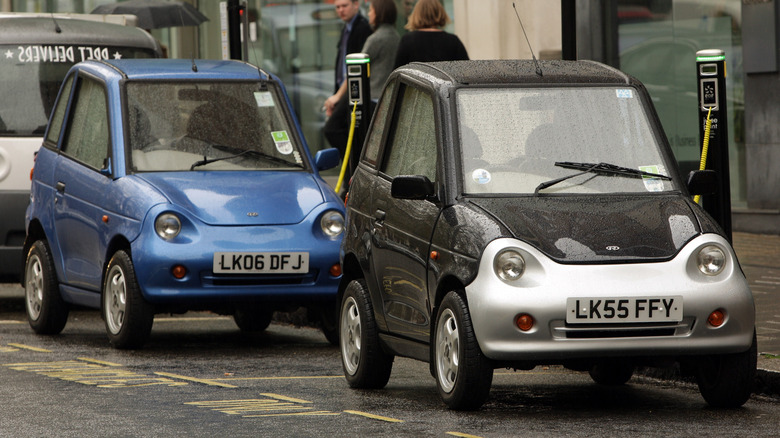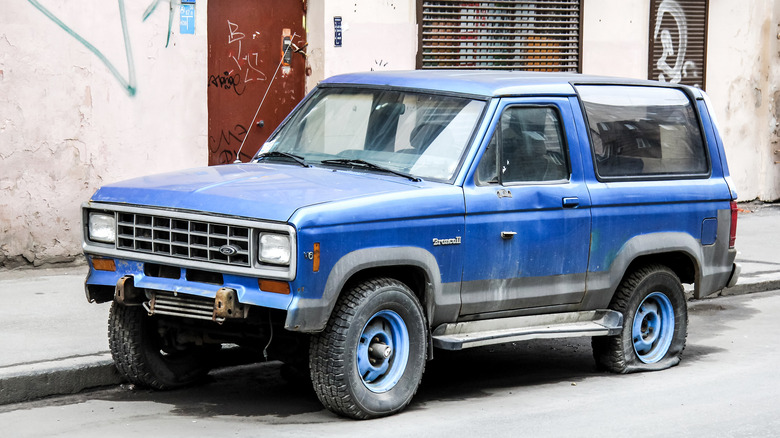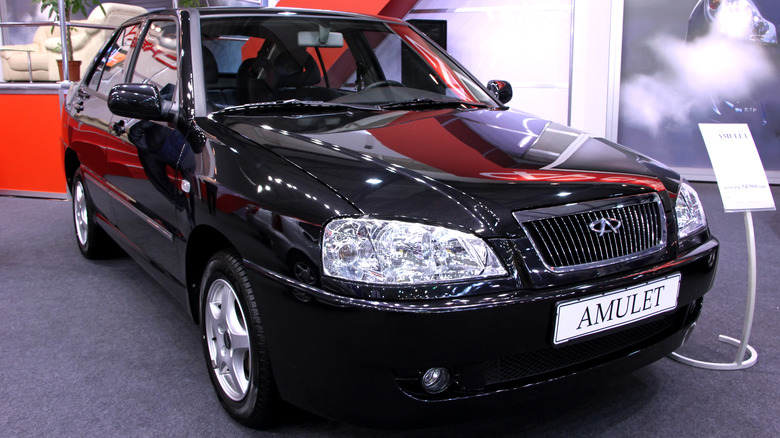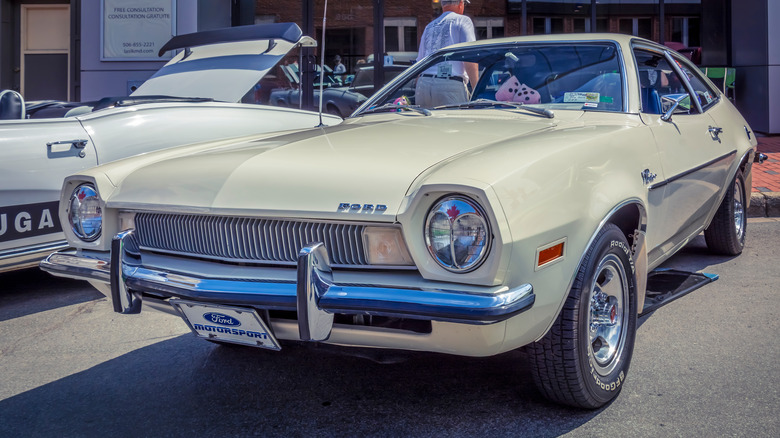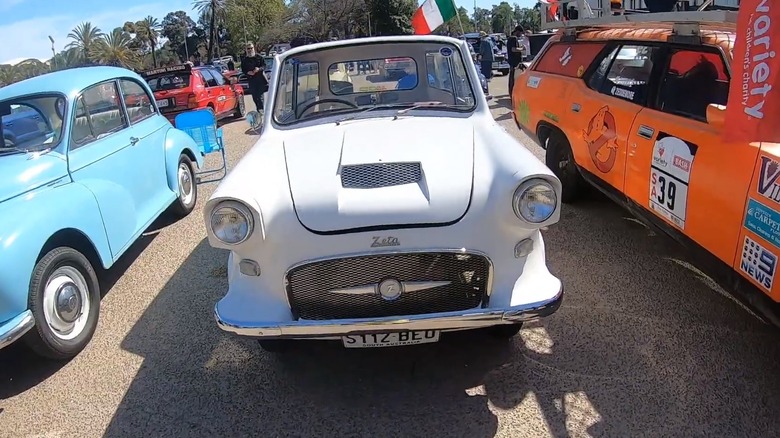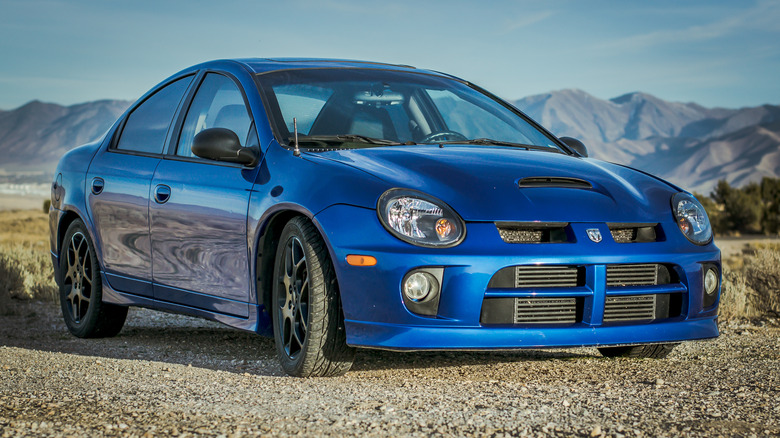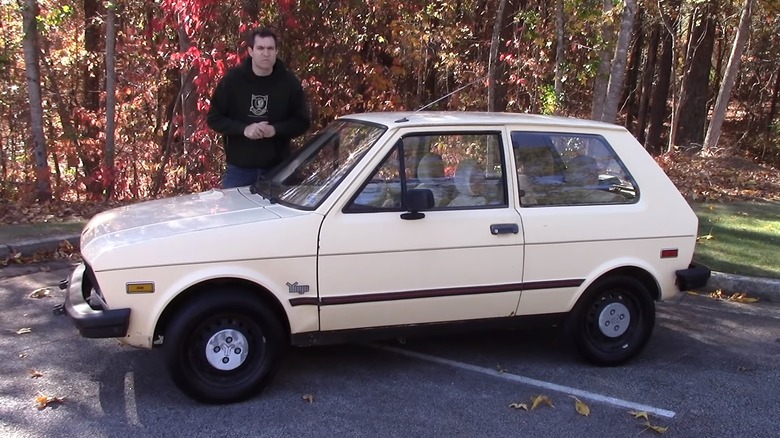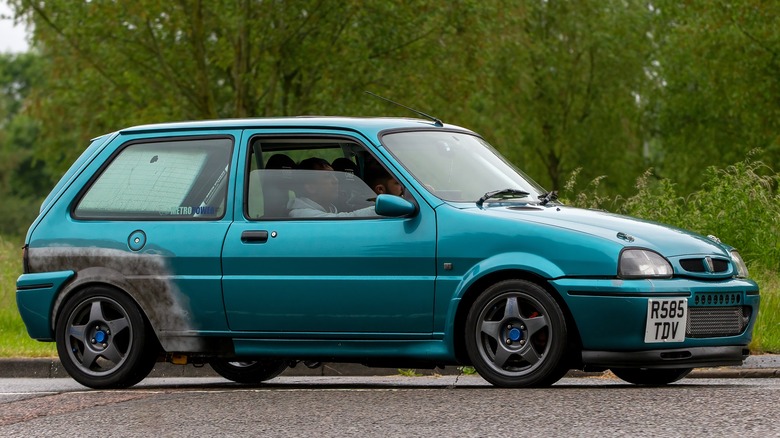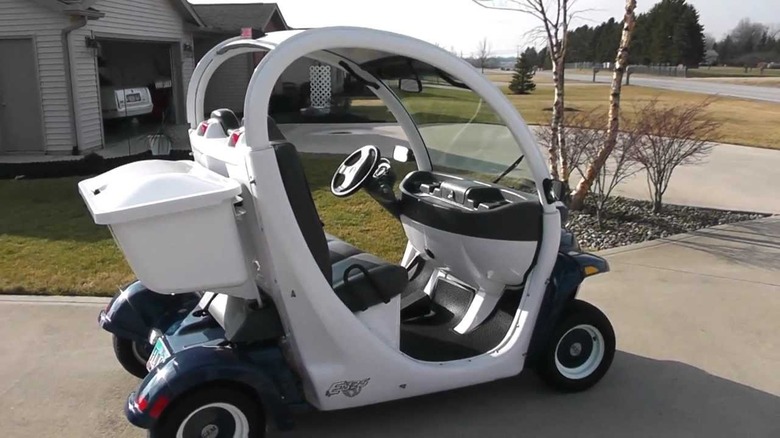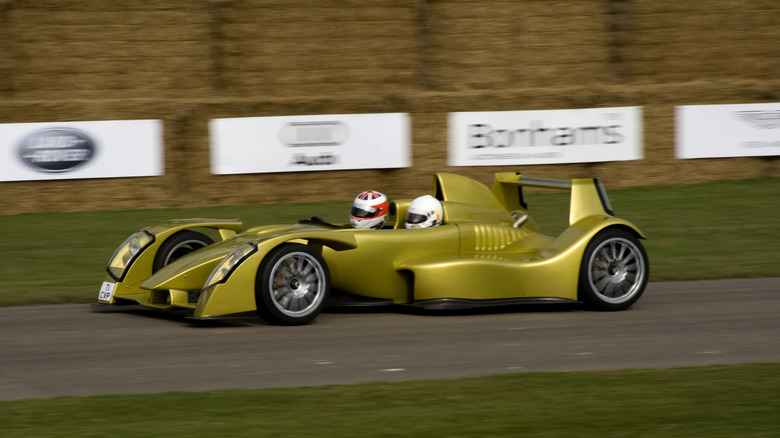Cars That Were Basically Rolling Death Traps
On the whole, modern cars are safer than ever. A total of 101 vehicles were given the award of Top Safety Pick by the IIHS in 2022, an increase of roughly 10% over the previous year's results. Modern crash safety regulations demand an ever-increasing number of airbags, crumple zones, and driver assistance systems to be present in today's cars, reducing the risk of injuries even if the car is involved in an accident.
However, it's not always been this way. Over the decades, automakers have produced plenty of vehicles that, should they get into a crash, could turn into rolling death traps for the driver and passengers. Many of them have virtually zero impact protection, and some even came with design defects that made them inherently dangerous to drive. In some cases, the manufacturers of these cars were hauled to court and faced damages over their defective products. But, often, the only people punished were the poor souls that were unfortunate enough to buy one of these cars.
Ford Bronco II
Ford recently relaunched the Bronco to great success, at one point even having to temporarily halt reservations because of the large amount of interest in the car. However, not every version of the Bronco has been so successful, with the Ranger-based Bronco II causing the company to have to shell out millions of dollars in damages. This was the result of a high-profile lawsuit that alleged that Bronco IIs were dangerously prone to rolling over when cornering, leading to potential injuries and even death for the occupants.
At first, Ford denied the issue, but the evidence mounted up. A total of 260 deaths were recorded as being caused by the Bronco II rolling over, several times more than any other similar vehicle, reported the Wall Street Journal in 1997. Ford eventually reached a settlement of $70 million from the lawsuit and ended up paying out over $113 million in total because of the scandal.
Chery Amulet
Built between 2003 and 2010, the Chinese-built Chery Amulet was sold in various export markets around the world, including South America, Russia, and Eastern Europe. It was based on the Seat Toledo, which itself was built on an aging VW platform that had been around since the '80s. It was cheap, but it was also spectacularly unsafe. Russian magazine Autoreview conducted a crash test that followed Euro NCAP regulations, and the car received the equivalent rating of zero stars, achieving just 1.7 points out of a potential 16.
Footage from the test and it's easy to see why it received such a shocking rating. When the car hits a barrier head-on, it crumples like paper, with the driver's side of the car being completely destroyed. In fact, the cabin was mangled so badly that the crash test dummy reportedly had to be disassembled before it could be removed from the wreckage. The test might have shocked those who saw the results, but it didn't stop the Amulet from becoming one of the best-selling Chinese vehicles in Russia, with up to 10,000 units sold per year.
Reva G-Wiz
Electric cars might be the future, but the Reva G-Wiz proves that buying an EV isn't always a good idea. It's been dubbed the "world's worst electric car" thanks to its tiny range, optimistic official top speed of 50 mph, and lack of any crash protection at all. Essentially a large plastic box with a battery strapped to it, the G-Wiz's terrible build quality meant that any collision above 30 mph would almost certainly prove fatal. A UK-based research laboratory conducted a 40 mph crash test on the G-Wiz, and the results showed that the car would almost completely collapse in on itself, with the test dummy being crushed to the point of near certain death.
Despite these horrifying results, the G-Wiz was sold in the UK for almost 10 years, only being pulled in 2011 due to low sales. It was also sold in 24 other markets around the world, with most owners living in crowded cities where traffic rarely exceeded 20 mph, as it wasn't much use for anything else. To top things off, the G-Wiz wasn't even that cheap, with GreenCarReports reporting that the car started at an equivalent price of $17,500, or $25,000 for the longer-range version.
Ford Pinto
Few nameplates are quite as infamous as the Ford Pinto, which gained a reputation during the '70s as "the barbecue that seats four." This was because of its tendency to explode during a collision, with the rear-mounted gas tank being prone to rupturing even in minor accidents. The worst part about the whole affair, though, was that Ford knew about this safety defect before the car ever made it to dealerships. According to the Spokesman, a memo was leaked that had been circulated among Ford executives, which calculated the cost of fixing the car versus settling the lawsuits arising from the expected deaths.
The Spokesman reports that Ford calculated that fixing the car would cost $121 million, whereas the lawsuits were only expected to cost around $50 million, so Ford knowingly sold the car with the deadly safety defect to save money. It turned out that, as the scandal became public, Ford would end up paying out significantly more in settlements than it expected, with one 1981 lawsuit alone costing them $6.5 million. It's estimated that around 9,000 people died due to the Pinto's defective tank, with tens of thousands more permanently scarred from burns.
Lightburn Zeta
Lightburn was an Australian manufacturer of washing machines, cement mixers, and other white goods. But, in the early '60s, they decided to branch out and make a car. The result was the Zeta, a simple microcar that was built as cheaply as possible. The car had a number of unique quirks, including doors that swung open 180 degrees to allow better access to the rear of the car. Power was provided by a two-cylinder motorcycle engine that made just 16 horsepower. Car Throttle reports that dealers would be reluctant to take families out on test drives, in case the Zeta couldn't handle the weight.
While the Zeta didn't suffer from the same catastrophic design failures as some of the other cars here, it had a unique feature that made it more dangerous than most other small cars: The fuel tank was fitted directly behind the dash, next to the driver. This ensured that any frontal impact had the potential to rupture the tank, spilling fuel onto the hot engine, right next to where the occupants were sitting. A disaster in waiting, but one that was averted, largely because the Zeta sold so poorly that there weren't enough on the road to get into any big crashes. Only 400 units were ever sold, despite the fact that the Zeta was the cheapest new car on sale in Australia at the time.
Dodge Neon
The second-generation Dodge Neon may look unassuming, but it hides a secret: it's statistically the most dangerous vehicle on American roads. Between 2002 and 2005 alone, the model saw 160 deaths recorded, more than any other at the time. This was mostly due to flaws with the car's safety features, which were documented in the IIHS test report from the era. In the standard side impact test, the driver scored a "poor" rating in every category, with the dummy's head even coming into contact with the protruding barrier. The driver's torso and legs were also at high risk of being crushed as the car buckled.
The Neon didn't fare much better in the moderate overlap test either, with the steering wheel snapping off the column on impact and the driver's side airbag partially missing the dummy's head. The driver's left leg was also assessed as having a high probability of being crushed on impact. Despite all these potentially deadly flaws, Dodge didn't do anything to make the Neon safer, and it continued to be sold for five years after the initial test was done.
Yugo GV
Malcolm Bricklin, the man responsible for introducing Subaru to America, also gave the country one of its most hated cars ever: the Yugo. Made in Communist Yugoslavia for a wholesale price of around $2,000, Bricklin imported the car into America and sold it for $3,995, making it the cheapest new car on sale in America at the time. It was, by all accounts, terrible: slow, basic, and with a rougher ride than its sloppy handling might imply. The Yugo was all the worst traits of an economy car rolled into one.
It was also, rather unsurprisingly, very unsafe. The Chicago Tribune reports that out of all the cars crash tested by the NHTSA in 1986, the Yugo was the worst by a considerable margin. In the test, the higher the number, the more likely an injury would be to occur. The Yugo scored 1,415 in the head injury category for the driver and 1,318 for the front-seat passenger. For context, a rival budget car, the Mazda 323 LX, scored just 802 and 894 in the same categories.
Rover 100
Throughout the early '90s, the Rover Metro supermini had been surprisingly popular at home in the UK, with its strong sales numbers catching even Rover by surprise. So, when the Metro needed to be replaced in 1995, the company decided to keep costs down and simply refresh the car's looks, then debut it as a new model, called the 100. The public wasn't fooled, and the 100 quickly gained a reputation as being outdated in the face of its fresher competition. But, it still sold in high enough numbers to keep it in production.
Then, in 1997, the Euro NCAP safety rating agency published a report that would essentially kill off the 100. The car was rated exceptionally poor in crash testing, failing to even meet basic safety requirements and becoming one of the worst cars ever reviewed in the process. The report was so bad that it reached the mainstream British media, even being discussed on the country's biggest news shows. Sales of the 100 dried up almost instantly, and Rover was forced to pull the car from dealerships as it simply couldn't sell them. This was one factor in the eventual bankruptcy and closure of Rover in the early '00s, bringing to an end a marque with nearly 100 years of carmaking history.
GEM E825
In response to California's zero-emissions mandate that required automakers to produce a small number of emissions-free vehicles every year, DaimlerChrysler acquired a small EV company, Global Electric Motorcars, in 2000. By 2001, the subsidiary had begun production of the E825, which was essentially a road-legal golf cart that was built to take advantage of the newly-passed LSV (Low-Speed Vehicle) laws. Under LSV exemptions, a vehicle could be registered for the road without having to meet any safety regulations, as long as its top speed didn't exceed 25 mph.
The E825 was engineered to top out at exactly 25 mph, and to keep costs down (and profits high), it was made entirely of flimsy plastic. Car and Driver tested the E825 when it was unveiled and called it "unnerving" to drive, suggesting the only place it would be useful would be in a planned neighborhood with little traffic. Even at 25 mph, the poor build quality and lack of any safety features meant that there was significant scope for injury should an accident occur.
Caparo T1
Originally a steelmaking company, Caparo branched out in the early '00s and launched its first supercar, the T1. It was heavily inspired by Formula 1 racing and it proved to be incredibly quick around a track, but it was also dogged by various reliability issues that turned it into a high-speed death trap. Racing driver Jason Plato suffered burns to his hands, neck, and face when the T1 suddenly caught fire during testing for a British TV show, and in a separate incident, the floor fell out of the T1 that Jeremy Clarkson was driving for a feature on Top Gear.
Other incidents reported by Road and Track include a T1 getting its throttle stuck open during a showcase at the Goodwood Festival of Speed, and a major suspension failure when a Dutch journalist was testing the car. All of these mishaps put off potential buyers, and the T1 struggled to find enough customers to make the project profitable. Production of the Caparo came to an abrupt halt after the company's CEO was found dead after apparently taking his life in 2015, a sad end for a car whose inherent dangers stopped it from making the impact it could have.
